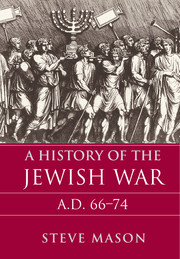Book contents
- Frontmatter
- Contents
- List of Illustrations
- List of Tables
- Acknowledgements
- Part I CONTEXTS
- Part II INVESTIGATIONS
- 4 WHY DID THEY DO IT?: ANTECEDENTS, CIRCUMSTANCES, AND “CAUSES” OF THE REVOLT
- 5 NERO'S WAR I: THE BLUNDER OF CESTIUS GALLUS?
- 6 NERO'S WAR II: FLAVIANS IN GALILEE
- 7 JERUSALEM I: JOSEPHUS AND THE EDUCATION OF TITUS
- 8 JERUSALEM II: COINS, COUNCILS, CONSTRUCTIONS
- 9 A TALE OF TWO ELEAZARS: MACHAERUS AND MASADA
- CONCLUSIONS
- Appendix
- Bibliography
- Bibliographical Abbreviations
- Index of Modern Authors
- Index to Historical Persons, Groups, and Places
- Index of Texts, Inscriptions, and Papyri
5 - NERO'S WAR I: THE BLUNDER OF CESTIUS GALLUS?
from Part II - INVESTIGATIONS
Published online by Cambridge University Press: 05 February 2016
- Frontmatter
- Contents
- List of Illustrations
- List of Tables
- Acknowledgements
- Part I CONTEXTS
- Part II INVESTIGATIONS
- 4 WHY DID THEY DO IT?: ANTECEDENTS, CIRCUMSTANCES, AND “CAUSES” OF THE REVOLT
- 5 NERO'S WAR I: THE BLUNDER OF CESTIUS GALLUS?
- 6 NERO'S WAR II: FLAVIANS IN GALILEE
- 7 JERUSALEM I: JOSEPHUS AND THE EDUCATION OF TITUS
- 8 JERUSALEM II: COINS, COUNCILS, CONSTRUCTIONS
- 9 A TALE OF TWO ELEAZARS: MACHAERUS AND MASADA
- CONCLUSIONS
- Appendix
- Bibliography
- Bibliographical Abbreviations
- Index of Modern Authors
- Index to Historical Persons, Groups, and Places
- Index of Texts, Inscriptions, and Papyri
Summary
He who has been beaten in an engagement with a standard battle array ‒ although even there, design is of great advantage ‒ can nonetheless in his defence accuse fortune. But he who has suffered a sudden attack, ambushes, or traps cannot deflect his own blame, because he could have avoided these things or, by means of competent scouts, discovered them in advance.
Vegetius, Epitome 3.22One of the great puzzles of the Judaean War is the event that set it in motion: the expedition to Jerusalem by the legate C. Cestius Gallus, in September–October of A.D. 66. Until that time, as we have just seen, Judaeans had been in conflict only with the largely Samarian auxiliary (Chapter 4). Now Cestius marched south with a reported force of 30,000, anchored in the Twelfth Legion, with auxiliaries and regional allies from the north plus ad hoc recruits (War 2.499–502). Within two months, most of that being travel time, he was back in Antioch, disgraced and disconsolate after losing an alleged 5,300 men. Even if the real number were much smaller, he suffered a serious humiliation. No one could doubt that this would swiftly be avenged. Judaeans began preparing for that retaliation (War 2.562–79). But how did Cestius come to such grief? What was he intending, and was he so utterly incompetent to see it through?
Assuming that Judaea was already in open revolt against Rome and that Cestius’ objective was to crush Jerusalem, analysts have found his behaviour baffling. His apparent dithering en route and abrupt departure from Jerusalem, capped by the catastrophic ambush in the Beit-Horon pass, have seemed evidence of staggering ineptitude. The successful ambush gave an incalculable boost to Judaean morale (War 3.9). And because it clearly demanded revenge, more than any other single event it created the Judaean-Roman War. Josephus’ formulaic repetition of “the blunder(s) of Cestius” brings this episode into the orbit of “the Varian disaster” (clades Variana) of A.D. 9, in which an emeritus legate of Syria lost three legions and his own life in Germany.
Cestius lived long enough to suffer the ignominy, but not long enough to redeem his reputation. A generation later Tacitus reflects that “he suffered varied fortunes and met defeat more often than he gained victory” (Hist. 5.10).
- Type
- Chapter
- Information
- A History of the Jewish WarAD 66–74, pp. 281 - 334Publisher: Cambridge University PressPrint publication year: 2016

